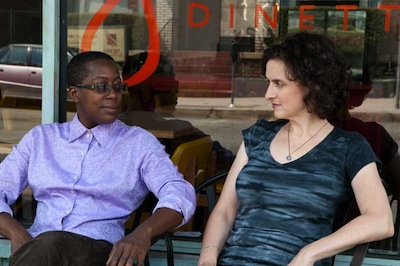
Cheryl Dunye - The Owls (2010)
(Cheryl Dunye and Lisa Gornick)
THE WOMEN'S FILM FESTIVAL FILMS
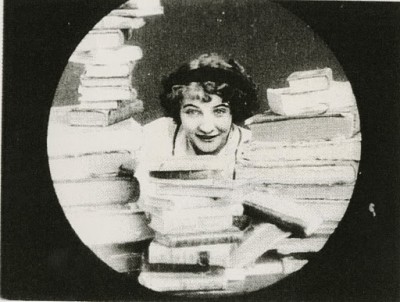
Lea and the Ball of Wool
(1913 / 5min)
This Italian short film from Cines depicts the catastrophic perils of forcing one's teenage daughter to stay home and knit when she would rather sit at her desk and read. Legendary but forgotten slapstick comedienne, Lea Giunchi, ravages her family's domestic space in a parodic quest for her misplaced ball of yarn.

The Owls ***NEW ENGLAND PREMIERE***
(2010 / 66 min)
DIRECTED BY Cheryl Dunye
A mysterious and attractive stranger walks into the lives of two lesbian couples, catching them in the middle of their relationship and mid-life crises. But it's not just middle age and the failed utopian vision of a Lesbian Nation that they are struggling with: there is also a dark secret, the guilt of the accidental killing of a younger lesbian that returns to haunt these women. Featuring some of the most popular artists in independent and lesbian cinema (V.S. Brodie, Guinevere Turner and Deak Evgenikos), The Owls combines fiction with the actors' reflexive musings on age, inter-generational dialogue, loneliness, and community.

The Women
(1939 / 133min)
DIRECTED BY George Cukor
The only film in the Women's Film Festival directed by a male, this 1939 MGM "women's film" features an all-female cast, and a diva-studded one at that—starring Joan Crawford (post-flapper, pre-eyebrows), Norma Shearer, Rosalind Russell, Paulette Goddard, Joan Fontaine, Marjorie Main, and Virginia Grey. The Women typifies many conventional associations with the classical Hollywood "women's film," from its tearjerker narrative, to its gossipy screwball dialogue, to its spectacular Technicolor fashion show sequence midway through the film. The Women's studio tagline really sums it up: "The Women. It's all about men!" Or is there more to say about The Women? Indeed, the film constructs many different, contradictory images of women: they are either "good" OR "bad," married and unemployed OR unmarried and employed in perfume sales, a beautiful mother OR an aimless busybody. Keeping in mind how the film erects a unified image of "the woman" by opposing and juxtaposing various gross caricatures of women, we might interpret The Women, at a deeper level, as a very interesting symptom of and discourse about the idea of the women's film.
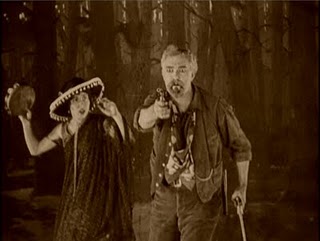
'49-'17
(1917 / 61min)
DIRECTED BY Ruth Ann Baldwin
Ruth Ann Baldwin directs this feminist parody of the Western genre in which a judge relives his glory days by hiring a theater troupe to restage the 1849 gold rush. An insightful and provocative reflection on the nostalgic temporality of the Western genre—whose mythification of untamed Western spaces was deeply complicit with the masculinist construction of white racial superiority in early narrative films—'49-'17 takes the silent Western's perverse obsession with reliving American history to its parodic limits. This film unfolds as a delightfully comical reflection upon the discourses of misogyny and xenophobia that were already well ingrained in American cinema culture by 1917.
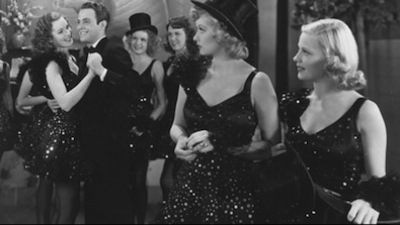
Dance, Girl, Dance
(1940 / 90min)
DIRECTED BY Dorothy Arzner
Dorothy Arzner critiques mainstream film codes from within the classical Hollywood studio system in this feminist musical from 1940. Maureen O’Hara plays Judy, an aspiring ballerina, who clashes both romantically and politically with burlesque dancer Bubbles (Lucille Ball). Dance, Girl, Dance subversively reworks the "good girl"/"bad girl" tropes that are at the ideological core of 1940s Hollywood entertainment. Through its playful invocation of numerous female stereotypes, including "the phallic woman" (Mme. Lydia Basilova), Dance, Girl, Dance gives depth and meaning to the fragments of female images that circulate unproblematically through this era of American film production. In fact, it is the uncomplicated male protagonists who wander through the picture without much psychological development or justification—what a striking reversal! Dorothy Arzner famously directed many hit feature films—Christopher Strong, First Comes Courage, and The Bride Wore Red—during a time when almost no other women worked as Hollywood film directors.
Anselmo and the Women
(1986 / 35min)
By the Lake
(1986 / 9.5min)
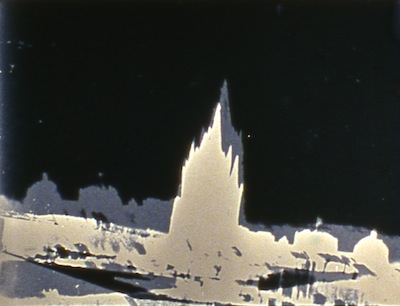
Waterfall
(1967 / 3min)
DIRECTED BY Chick Strand
Chick Strand (1931-2009) was a California-based experimental filmmaker and teacher who co-founded the still-functioning Canyon Cinema film cooperative with Bruce Baillie in the early 1960s, while earning a degree in anthropology at UC Berkeley. Though she produced an impressively diverse body of work over the course of her life, including a range of experimental collage films employing found sound and images (which include By the Lake (1986) and Waterfall (1967) ), she is perhaps best known for her thrillingly unconventional approach to filmic ethnography, which she began practicing while studying at UCLA's Ethnographic Film Program in the late 60s. Strand's version of ethnography, exemplified by Anselmo and the Women (1986), seeks to surpass the "objective" and scientific ambitions of traditional documentary in order to create a more vital, and consciously artistic representation of a culture that would not elide its particular spiritual and emotional characteristics, its "heart and soul" in Strand's words. Her ethnographic films are also political in their exploration of the social frameworks, gender hierarchies, and power dynamics that structure and delimit the daily lives of Third World women. In Anselmo and the Women, Strand explores the life of a Mexican musician and farmer, his wife, and his mistresses, attending to the emotional and social dilemmas of each of these subjects, while also exploring, through stunning employments of extreme close-ups, the intensely tactile and lyrical dimensions of women's labor. By the Lake appropriates and recombines found footage of the Third World with decontextualized sounds of medical operations and religious rituals to approximate what Strand termed an "Anglo woman's interpretation of magic realism." Waterfall, produced with the aid of an optical printer while Strand was still a student at UCLA, creates a psychedelic experience of flowing, shifting half-forms and images that speaks to Strand's strength as a visual artist as well as her abilities as an editor.

W.O.W. Women of the World
(1975 / 10min)
DIRECTED BY Faith Hubley
W.O.W. (Women of the World) is Faith Hubley's first solo film and it was completed in 1975 shortly after she was diagnosed with breast cancer. This animated short depicts a feminist history of the earth told through art and collage. Prior to W.O.W. (Women of the World) Hubley collaborated with her husband, John Hubley, and Garry Trudeau on a televised animation of the comic strip Doonesbury.
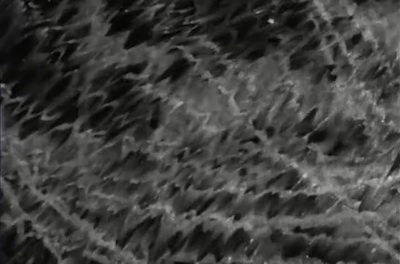
River Lethe
(1985 / 7min)
DIRECTED BY Amy Kravitz
Amy Kravitz's River Lethe is an animation that moves between the abstract and images that almost achieve a recognizable form before dissolving back into themselves, escaping their uncanny resemblance back into objects that could only be recognizable to the unconscious. The images themselves are incredibly rich and distinct due to their composition in graphite and aluminum.
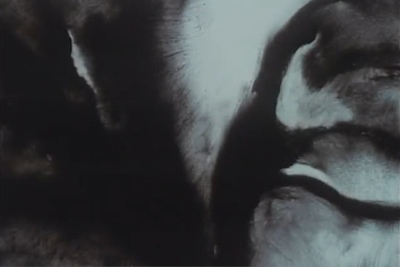
Roost
(1998 / 4.5min)
DIRECTED BY Amy Kravitz
Amy Kravitz's Roost combines abstract imagery, text, and a frenetic and often frightening soundtrack. This short animation suggests the violence and destruction inherent in the concept of origins. It is a bleak meditation on themes of belief, violence, and abandonment.

Meditation on Violence
(1948 / 12 minutes)
DIRECTED BY Maya Deren
Acclaimed filmmaker Maya Deren's (Meshes of the Afternoon (1943), Ritual in Transfigured Time (1948) ) study of violence through the abstracted motif of Wu-Tang and Shaolin-style shadowboxing and swordplay. The rigorously choreographed precision of these solitary exercises in martial arts, performed by Chao-Li Chi and accompanied by classical Chinese flute music and Haitian drumming, gesture at their brutal application while simultaneously blurring any hard distinctions between aesthetics and violence.
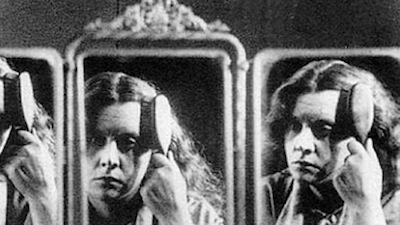
The Smiling Madame Beudet
(1923 / 54 min)
DIRECTED BY Germaine Dulac
Directed by French cinema pioneer Germaine Dulac, and scripted by André Obey from a story by Guy de Maupassant, the 37-minute piece concerns the dissatisfied bourgeois housewife of a thoughtless, self-centered shopkeeper. Decades of marital submission have reduced Mme. Beudet to depression and ennui, and have rendered her an emotional prisoner to her world and herself. Her rich fantasy world, however, consists of breezy, idyllic and lyrical interludes with a host of young, handsome paramours. Mme. Beudet also fantasizes about laying waste to her husband – but every such hopeful wish fizzles out as she resurfaces in the reality of the everyday. Throughout the picture, Dulac uses such devices as slow motion, distortions, and superimposed images to paint Beudet's various emotional states onscreen. The Smiling Madame Beudet established Dulac in the film world and stands as a mark in the timeline of women in film.
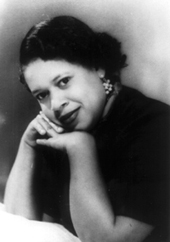
Remembering Wei Yi-fang, Remembering Myself
(1995 / 29min)
DIRECTED BY Yvonne Welbon
Yvonne Welbon was granted P.O.V. finishing funds, a Sidney Poitier Emerging Filmmaker Fellowship and a Center for New Television / NEA-AFI Regional Fellowship for Remembering Wei Yi-fang, Remembering Myself The award-winning documentary is an autobiographical film about Welbon's experiences as an African American woman living in Taiwan for six years. The film contemplates the "accidental" nature of identity politics by comparing two catastrophic events—one historical and the other biographical—that shaped Welbon's own racial and national identifications: a slave trade shipwreck that rerouted her ancestors from the US to Honduras, and a motorcycle crash that compelled Welbon to repatriate to America after six years abroad in Taiwan. Through its rigorous narrative parallelism between the politics of history and autobiography, Wei Yi-fang provokes questions about the women's film's own national, sexual, and historical hybridity.
The film was broadcast on the national Public Television series P.O.V. in 1996. Remembering Wei Yi-fang, Remembering Myself won a Silver Hugo at Intercom: The Chicago International Film Festival, and was named Best Film/Video on Matters Relating to the Black Experience at the 11th Black International Cinema Festival in Berlin.

Sisters in Cinema
(2000-2003 / 57min)
DIRECTED BY Yvonne Welbon
Sisters in Cinema gives voice to African-American women directors and serves to illuminate a history of independent filmmaking that has remained hidden for too long. In the summer of 1997, Welbon produced and directed a segment about her work-in-progress for Split Screen, a program about independent filmmakers that highlighted the films of black women directors Eloyce Gist, Zora Neale Hurston, Julie Dash, Darnell Martin and Bridgett Davis. By unearthing and representing the work and stories of many overlooked African American women directors, Sisters in Cinema foregrounds problems in mainstream film historiography and challenges the institutional structures that have hampered African American women film directors.
Don't miss the Q&A session after this screening with the film's director, Yvonne Welbon!
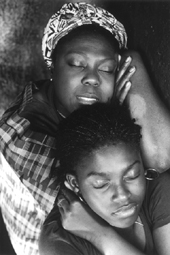
Home Away from Home
(1994 / 11min)
DIRECTED BY Maureen Blackwood
A meditation on exile and spiritual communion, this prize-winning short film centers on the experiences of an immigrant black woman, Miriam, in the UK. Miriam lives close to Heathrow Airport, and the planes flying over her cramped house constantly remind her of her displacement from Africa. She finds a way to deal with her exile: she builds a mud hut in her garden to re-connect with what she thinks of as home. Miriam's neighbors are not happy, but her daughter Fumi begins to acquire a sense of her cultural roots.
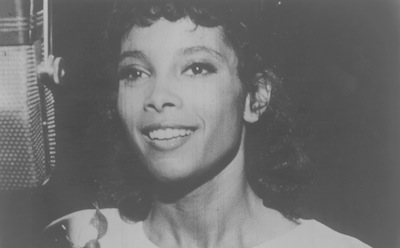
Illusions
(1982 / 34min)
DIRECTED BY Julie Dash
In her short film, Illusions, acclaimed African-American filmmaker Julie Dash makes an important intervention in the historical narrative of Hollywood. The film follows the plight of a black female studio executive who passes for white and a black woman who becomes the singing voice for a white star in a musical. By addressing the simultaneous visibility and invisibility of African-American women within the studio system, Dash calls attention to and ultimately disrupts the illusory nature of the industry in favor of embracing the gendered and racialized realities of Hollywood.
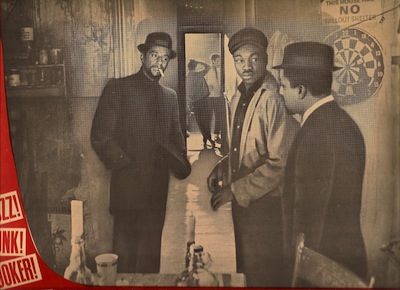
The Cool World
(1964 / 105min)
DIRECTED BY Shirley Clarke
New York independent filmmaker Shirley Clarke portrays the harsh daily lived realities of Harlem youth immersed in street gang culture in her ambitious feature film, The Cool World. Adapted from the novel by Warren Miller, The Cool World follows Duke, a teenager with aspirations to become the leader of his gang and to fight against the white establishment. Inspired by Italian neo-realist cinema, Clarke's stark depiction of the New York City urban environment highlighted her commitment to cinéma vérité aesthetics and to film as sociopolitical critique. With fellow avant-garde filmmakers Maya Deren, Stan Brakhage, and Jonas Mekas, Clarke sought to define a new wave of American cinema that recognized film's revolutionary qualities and called for an alternative to Hollywood moviemaking. Though her film and later video art work never explicitly dealt with women or women's issues, her presence as a pioneering independent U.S. filmmaker is still felt in the contemporary moment and could serve as a point of departure to re-envision feminist filmmaking politics and practice.
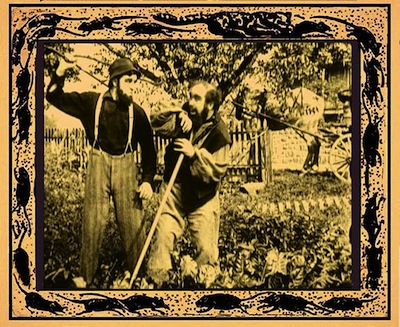
Making an American Citizen
(1912 / 16min)
DIRECTED BY Alice Guy-Blaché
The discourse of Americanization was a popular cinematic subject in films from the Nickelodeon boom (1906) onward. Indeed, cinema served as a vital medium for "educating" immigrant film spectators with object lessons about the meanings of American national identity. This somewhat tongue-in-cheek film from ex-pat French director Alice Guy-Blaché, produced by her American film company Solax, both performs and parodies its title subject: what it takes to "make an American citizen." Other than loyal kinematograph patronage, those masses of ethnic "others" can aspire to patriotic legitimacy by learning from film protagonist Ivan Orloff's mistakes. Guy-Blaché provides a feminist take on early cinema's discourse of Americanization in this humorous short, in which Ivan and his immigrant friends learn, among other things, how not to treat their wives...
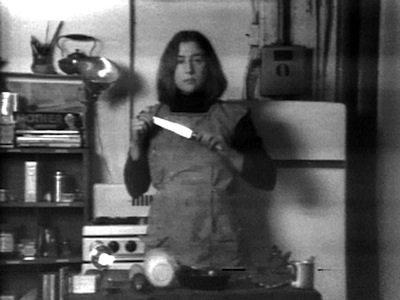
Semiotics of the Kitchen
(1975 / 6min)
DIRECTED BY Martha Rosler
The headline on the September 15, 2010 issue of the National Enquirer loudly proclaims "Kitchen Divas at War!" with lurid gossip inside about how Rachael Ray, Martha Stewart, and Paula Deen are practically at each others' throats off-set. Perhaps these culinary celebrities might do well to take a page from Martha Rosler's Semiotics of the Kitchen (1975), a performance piece on video that interrogates the domestic politics of the kitchen and the women who spend their time there. In this six-minute short, Rosler methodically dissects the alphabet using kitchen implements that she wields in a combination of satire, rage, and frustration. To mistake Rosler's video as mere second-wave feminist anger, however, not only would be an oversimplification of her critique of the happy housewife, but would ignore the way in which the video engages with the apparatus of the television itself. As Rosler moves from letter to letter, from kitchen tool to kitchen tool, she discards each semiotic and culinary device in an act that rethinks "outside-the-box" television programming.
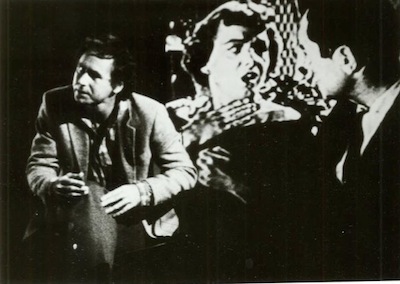
The Man Who Envied Women
(1985 / 125min)
DIRECTED BY Yvonne Rainer
In The Man Who Envied Women, Yvonne Rainer, dance choreographer turned independent filmmaker, stands feminist film theory's fixation with the problem of female lack onto its head. The Man Who Envied Women represents female gender as a splitting between self and self-image: disembodied female voiceover (choreographer Trisha Brown) provides a feminist meta-narrative for glimpses of the film's womanizing protagonist, Jack Dellar (played by two different actors), while he passes through various segmented spaces. The Man Who Envied Women deconstructs the gendered spaces of the everyday, transporting us from the New York City streets where Jack eavesdrops on women's private conversations, to his bourgeois home where he breaks up with his girlfriend while exercising on a Nordic Track machine, to the cinema where he watches classical Hollywood "women's films." Interweaving Bette Davis film clips, photographs of Central American genocide victims, Cold War radio broadcasts, spoken passages from feminist film theory, and experimental depictions of bourgeois domestic space, The Man Who Envied Women represents a rigorously humorous and self-reflexive discourse on the idea of the women's film.
Don't miss the Q&A session after this screening with the film's director, Yvonne Rainer!

MURDER and murder
(1996 / 113min)
DIRECTED BY Yvonne Rainer
Yvonne Rainer's MURDER and murder follows a new lesbian couple as they struggle with the recent discovery that one of them has been diagnosed with breast cancer. The film balances between the narrative of the couple, a pair of historically removed but interested relatives who haunt the narrative and provide a bridge to the more reflexive moments of the film which directly address the politics of breast cancer, specifically as it relates to lesbians. A deeply personal film, Rainer appears throughout the film, mixing the dialogue of the characters in the narrative with her own monologues that upsets the relative convention (at least for Rainer) of the form of the narrative portion. This will be a very special screening of this film with the director present to answer questions and talk with the audience about her filmic and artistic practice.
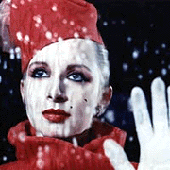
Ticket of No Return
(1979 / 107min)
DIRECTED BY Ulrike Ottinger
A challenging feminist parody by German director Ulrike Ottinger, Ticket of No Return examines the relationship between two eccentric and extremely different women. One wealthy and repressed, the other vulgar and notorious, both share a fatal attraction to alcohol consumption. The film's humorously slow-paced tragedy unfolds as the two women tempt one another to overcome their differences by parodying the other's morbid behavior and obsessions. The impossible reconciliation of these grotesquely opposed female personae lurches towards a morbid climax in Ticket of No Return, a self-reflexive film that contemplates the cinematic medium's own perverse re-animation of dead time within the space of female desire. Set against the cultural backdrop of 1970s Berlin, the film exposes the city's "drinkers' geography" as various tourists, musicians, workers, writers, artists, and intellectuals lend "authenticity" to the film's hyper-stylized aesthetic landscape.

Rules of the Road
(1993 / 31min)
DIRECTED BY Su Friedrich
Su Friedrich’s films (Sink Or Swim and Hide and Seek) depict queer American stories and biographies by experimenting with mainstream narrative film form. In this playful road movie, a lesbian couple’s romantic bond literally hinges on their attachment to a single commodity object: an old beige station wagon with fake wood paneling.
A typical American family car for an atypical American family, it provides the women at first with all the familiar comforts. But when their relationship ends, the car becomes the property of one and the bane of the other's existence. Even long after their separation, this tangible reminder of their life together—and thousands of its imitators—continues to prowl the streets of the city, haunting the woman who no longer holds the keys either to the car or the other woman's heart.
Through spoken text, popular music and images from the streets of New York, Rules of the Road takes a somewhat whimsical, somewhat caustic look at how our dreams of freedom, pleasure, security, and family are so often symbolized by the automobile.
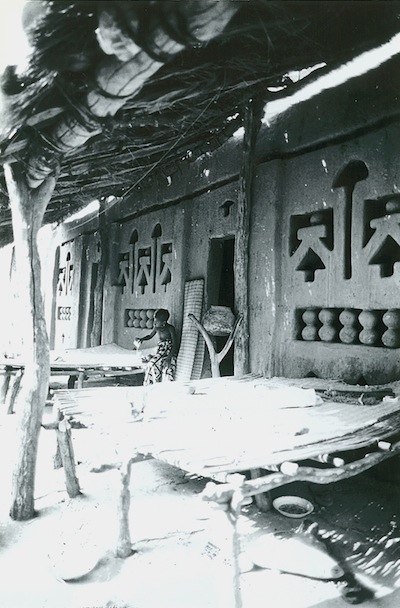
Reassemblage
(1983 / 40 min)
DIRECTED BY Trinh T. Minh-ha
Shot in Senegal and coming out of Minh-ha's fieldwork in West Africa, this film challenges the conventions of traditional ethnographic documentaries by abandoning the omniscient narrative voice: "I do not intend to speak about/Just speak near by..." says the filmmaker's voice-over in the film. Minh-ha's montage of fleeting but compelling images from rural Senegal forces viewers into a reflexive position: how does one represent the racial other and/or another culture without inflicting violence on the "object" of representation? What does it mean to be a filming, recording and viewing "subject"? Can the subject/object hierarchy be done away with?

Riddles of the Sphinx
(1977 / 92min)
DIRECTED BY Laura Mulvey and Peter Wollen
Laura Mulvey's second project with husband Peter Wollen is a formalist film exploring the female identity, the loss of and search for which as part of motherhood. Following Mulvey's articles on feminist film theory, Riddles of the Sphinx addresses her discourses on gender theory and psychoanalysis, among many other topics. The film centers on Louise, a mother struggling to take care of her child after her husband leaves while maintaining a job in a patriarchal society. Mulvey and Wollen use Louise's story as a way to explore gender politics, and use the film as a medium with which to explore film form. The film is divided into chapters, among which are segments of Mulvey addressing the camera with background information, Louise's story, and more abstract scenes such as female acrobats. Its most notable stylistic element is the use of 360-degree pans that immerse the audience in the environment of the film.
"What recurs overall is a constant return to woman, not indeed as a visual image, but as a subject of inquiry, a content which cannot be considered within the aesthetic lines laid down by traditional cinematic practice." – Laura Mulvey
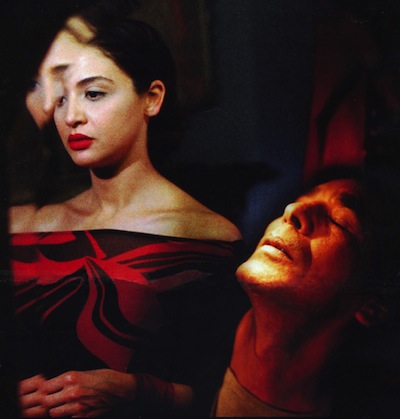
Kiss Me Not on the Eyes
(2005 / 112min)
DIRECTED BY Jocelyn Saab
Better known as DUNIA, this provocative and entertaining Egyptian/French/Lebanese co-production is the third feature film by Lebanese director Jocelyn Saab. The film depicts the plight of Dunia, a 23-year-old aspiring dancer and poet who feels constrained by the rigid gender codes of Egyptian society. After studying literature in Cairo, Dunia decides she wants to become a professional dancer. She auditions for an oriental dance contest by performing her own feelings of passionate containment: Dunia intrigues the dance contest judges by reciting Arabian romantic poetry without any body movement at all. She explains her performance as a reflection of her own experiences of gender repression in Egyptian society. Dunia's quest for performative expression is intensified by her budding romance with Beshir, an intellectual and activist who supervises her thesis on ecstasy in Sufi love poetry. The film provokes questions about the potential for feminist liberation by depicting the entanglement between Dunia's personal, romantic, and political struggles for gender equality.
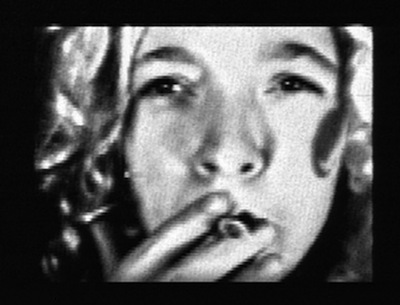
It Wasn't Love
(1992 / 20min)
DIRECTED BY Sadie Benning
Sadie Benning made her first video at the age of fifteen, with a Fisher-Price Pixelvision camera, a Christmas gift from her father and experimental filmmaker James Benning. The early autobiographical video work of Sadie Benning delights in a camp pastiche and a trash aesthetic that uses B-movies, TV news, popular and underground music. Parodying stereotypes of "ideal" femininity and of the "murderous lesbian," It Wasn't Love is at once a playful and a serious collage of Hollywood cinema, Benning's videos of herself and the enactment of her teenage erotic fantasies. Watch out for Bennings's brilliantly camp use of The Bad Seed (1956)—the story of the "perfect" little girl called Rhoda who turns out to be a serial killer—as well as the various roles that the artist casts herself in.

Hooker on Campus
(2007 / 5min)
DIRECTED BY Lena Dunham
Hookin' ain't easy — especially when you're working a liberal arts college campus.
Despite the promise of the title, there is no actual solicitation in Lena Dunham's short Hooker On Campus, though not for lack of trying. In this witty and painfully biting short, Dunham explores the picturesque boredom of a small liberal arts college atmosphere, playing up a handful of stereotypes (the activist, the overtalkative straight guy, the disinterested hipster) all from the perspective of a short skirt and a pair of busted black leggings. Dunham, who wrote, shot, and released this short while attending Oberlin College, has said that she was inspired by the comedy of Amy Sedaris - which might explain why she wasn't able to use her p***y to defray some of her student loans.
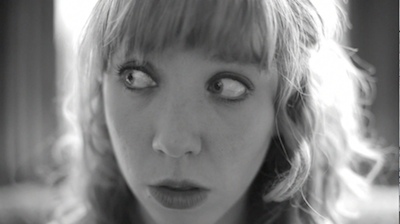
Blood Magic
(2009 / 17min)
DIRECTED BY Sonya Goddy
Claire Robbins, a seemingly modern girl who nonetheless harbors conventional romantic desires, is devastated when her boyfriend Lucas breaks up with her. When she happens upon a flyer advertising a "spiritual love advisor" who promises "radiant happiness in love," she follows its instructions to a mystical woman who offers her advice on the topic of how to "bind a man." The next morning when Claire wakes up, she finds herself in a completely different world.
Blood Magic plays with genre and expectation, at once macabre, comedic and even satirical in its use of mainstream conventions. The film's story follows Claire on a journey through both the supernatural and the mundane, ending with an unexpected act of rebellion.
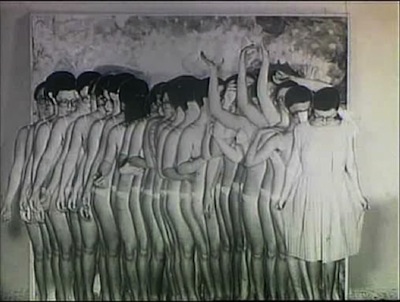
Doll Clothes ***CANCELLED***
(1975 / 2.5min)
DIRECTED BY Cindy Sherman
Cindy Sherman's Doll Clothes appears early in her career and it foretells some of the themes that recur throughout her more well known projects such as the Untitled Film Stills. Doll Clothes hints at Duchamp's Nude Descending a Staircase with paper dolls and animation as it addresses themes of commodification and sexuality. The paper doll appears to dress itself and begin to wander, simultaneously evoking both the strange subjectivity of Marx's commodity and a desire to escape from its own commodity filled existence. Doll Clothes is a lesser known work from one of the most well known and discussed American artists of the late-20th century.
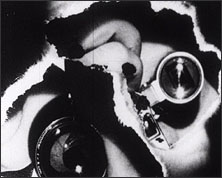
Light Reading
(1978 / 20min)
DIRECTED BY Lis Rhodes
Lis Rhodes’s Light Reading addresses issues of language, violence, faciality, and the image. Rhodes’s film plays off of its title to invoke the cinematic form itself but also its own literalization of that metaphor in its subject matter. Light Reading is a key text in the British movement of materialist film and it has been invoked in debates about the political efficacy of a cinema that has abandoned any pretense to pleasure. This rare screening is not to be missed.

Daughters of Chaos
(1980 / 19.5min)
DIRECTED BY Marjorie Keller
Marjorie Keller imagined her cinema to be a refutation of feminist film theory because it "obfuscates women’s filmmaking in the name of feminism." This polemical stance was controversial in the 1970s and 1980s and has led to some ignorance of Keller’s work. At the time of her death in 1994, Keller taught at the University of Rhode Island and was married to P. Adams Sitney. This is a very rare exhibition of Keller’s work and one not to be missed.
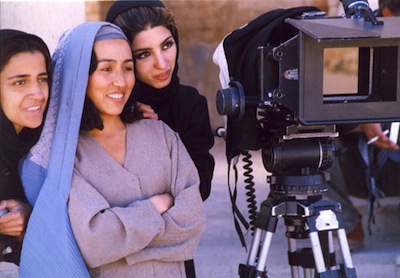
God, Construction, and Deconstruction in 11'09''01
(2002 / 11min)
DIRECTED BY Samira Makmalbhaf
11'09"01 is an international collaboration between eleven directors, each from a different nation. The project, which received the UNESCO award at the 2002 Venice Film Festival, is a collection of eleven short films, each eleven minutes and nine seconds on a single frame. Each short reveals a different national and cultural perspective to the September 11, 2001 World Trade Center Attacks. Although Samira Makhmalbaf hails from Iran, her short, God, Construction, and Deconstruction, takes place in Afghanistan, where young schoolchildren react to the Twin Towers' collapse. The children, whose responses range from deeply religious metacommentary to playful nursery rhymes, must somehow grapple with not only an event with severe geopolitical consequences - we are in Afghanistan, after all - but also with death in its most abstract. Fun fact: Makhmalbaf was twenty-two when she shot this short.
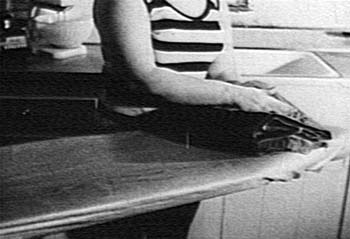
The Woman's Film
(1971 / 40min)
BY Third World Newsreel
The Woman's Film was made entirely by women in San Francisco's NEWSREEL, an alternative media organization that supports independent arts. It was a collective effort between the women behind the camera and those in front of it. The script itself was written from preliminary interviews with the women in the film, all ordinary women from different classes, races and education levels.
"...What we see is not only natural and spontaneous, it is thoughtful and beautiful. It is a film which immediately evokes the sights and sounds and smells of working class kitchens, neighborhood streets, local supermarkets, factories, cramped living rooms, dinners cooking, diaper-washing, housecleaning, and all the other 'points of production' and battlefronts where working class women in America daily confront the realities of their oppression. It is...a supremely optimistic statement, showing the sinews of struggle and capturing the essential energy and collective spirit of all working people-and especially that advanced consciousness which working class women bring to the common struggle." - Irwin Silber, Guardian

The Last Slide Projector
(2006 / 60min)
DIRECTED BY Paige Sarlin
The Last Slide Projector tells the story of the production of the last Carousel slide projector by Eastman Kodak. Beginning with Kodak's announcement of their decision to cease production and ending with a home movie-style digital video that documents the assembly of the last projector in Rochester, NY, the film chronicles the stories of people who were intimately involved with the production and use of the projector. The film documents the end of an era and traces the varied histories of an apparatus and a medium that have been central to family memories, to education, to art history and to the development of both cinema and corporate culture. Exploring a prime example of the transition from the analog to the digital, The Last Slide Projector offers a personal meditation on the idea of technological progress and the impulse toward nostalgia that loss and endings often inspire.
Don't miss the Q&A session after this screening with the film's director, Paige Sarlin!

The Cabbage Fairy
(1896 / 3min)
DIRECTED BY Alice Guy-Blaché
Alice Guy-Blaché directed over 700 films for Gaumont and Solax in France and the US between 1896 and 1922. Although one of the most prolific early filmmakers, and arguably the "first" woman film director during a period in cinema history when there were no "directors," Guy-Blaché's memory has been rendered largely invisible by mainstream film histories. In this early French short, The Cabbage Fairy, Guy-Blaché represents the popular fairy tale that human babies are farmed from cabbage patches.

Where Are My Children?
(1916 / 62min)
DIRECTED BY Lois Weber
Social reform activist and silent filmmaker Lois Weber (director of Shoes and Birth Control) promotes the merits of birth control in this sentimental and highly controversial feature film from 1916. Tyrone Power Sr. plays an activist District Attorney with a curiously infertile wife. Universal Studios successfully promoted this film by sensationalizing and misrepresenting the State Board's censorship campaign against it. The class politics of birth control advocacy are particularly fraught in Where Are My Children? Indeed, this film provokes questions about the murky line that divides reproductive rights from eugenics in popular narrative cinema from the 19-teens.
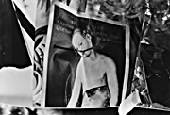
Peggy and Fred in Hell
(1984-2008 / 90min)
DIRECTED BY Leslie Thornton
Leslie Thornton's Peggy and Fred in Hell follows two young children as they navigate a post-apocalyptic media/landscape that traverses style, genre, and even medium. Indeed, what is perhaps most intriguing about Peggy and Fred in Hell is the way that it differentiates itself from the medium in which it is presumably functioning. Thornton's film is, in fact, only partially a film. It mixes film with video in order to question the filmic essentialism of the earlier structural filmmakers and to expand the definition of the medium. This first film led to a whole series of films that follow the children introduced here through a truly unique science fiction saga.
Don't miss the Q&A session after this screening with the film's director, Leslie Thornton!
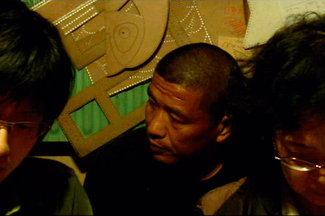
Oxhide II
(2009 / 133min)
DIRECTED BY Jiayin Liu
Shot in "real time," Oxhide II documents the unfolding of Chinese domestic politics within the temporal constraints of how long it takes to prepare and to consume Chinese dumplings. Just as in her previous film, Oxhide, Chinese director Jiayin Liu films herself and her parents in their claustrophobic apartment with documentary realism. Using nine fixed camera positions, Oxhide II revolves clockwise around the kitchen table, so that the last shot has exactly the same perspective as the first. Although the film’s space eventually comes full circle (not to spoil the ending), the extended temporal duration of the shots, which each range between 5 and 20 minutes, vividly contradict the close framing of their composition—the characters themselves often exceed the limits of the frame. Indeed, the film complicates its own cyclical unity by representing the tensions between its temporal duration and its constrained visual horizon. This friction between time and space provides a cinematic meta-discourse for thinking about how the family fixates on their dumpling preparation while discussing weightier problems and questions regarding the domestic politics of everyday life in China.
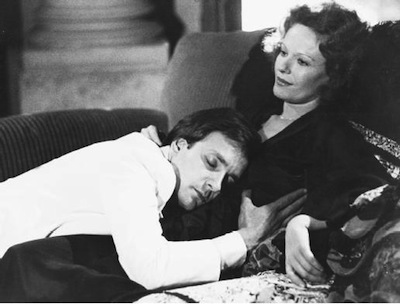
India Song
(1975 / 120 minutes)
DIRECTED BY Marguerite Duras
Writer and director Marguerite Duras (Hiroshima Mon Amour (1959), Le Camion (1977) ) harks back to her childhood in French colonial Indochina for an impressionistic meditation on love, power and loss set in 1937 Calcutta. Through a series of long, meditative takes accompanied by a disembodied soundtrack, Duras parallels the drawn-out sickness of European colonialism with a tragic love triangle between the mysterious Anne-Marie Stretter (Delpine Seyrig), the Vice-Consul of Lahore (Michael Lonsdale), and another colonial suitor, Michael Richardson (Claude Mann). Shown here in a rare, subtitled print from the Modern Culture and Media archives, Duras' languorous masterpiece is not to be missed.